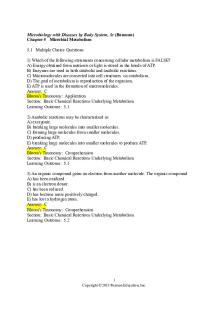5 - chapter 5 PDF

| Title | 5 - chapter 5 |
|---|---|
| Course | Biology |
| Institution | Victorian Certificate of Education |
| Pages | 3 |
| File Size | 91 KB |
| File Type | |
| Total Downloads | 52 |
| Total Views | 201 |
Summary
chapter 5...
Description
5.4- malfunctions in homeostatic mechanisms A malfunction in a homeostatic mechanism causes an imbalance and a subsequent oversupply or undersupply of substances to cells. Diseases of the endocrine system fall into three groups:
hypersecretion (oversupply) of hormones hyposecretion (undersupply) of hormones cancers of endocrine glands
Examples of diseases of endocrine glands include diabetes, graves' disease, Cushing's disease, gigantism Symptoms of type 1 diabetes:
glucose in the urine increased urine production excessive thirst excessive hunger ketosis weight loss Fatigue blurred vision Irritability muscle cramps skin infections delayed wound healing tingling or numbness in the feet .
Type 1 diabetes:
Is caused by a malfunction of the pancreas, which leads to a deficiency in insulin secretion. It is an autoimmune condition in which the body's immune system destroys the insulin producing beta cells in the islets of Langerhans in the pancreas
Treatment of type 1 diabetes involves:
artificially increasing the insulin supply by injections or an insulin pump. Pancreas transplant Gene therapy- gene that codes for insulin is inserted into patients cells
Management of type 1 diabetes:
Artificial insulin: injecting insulin Transplants: pancreas transplant Gene therapy: gene which codes for insulin is inserted into the patient's cell
Type 2 diabetes:
is also a disturbance of glucose homeostasis. In this disorder the pancreas still makes insulin, but the body cells do not respond This form of diabetes often appears later in life, but is increasingly common in younger people. it is more common in those who are overweight or obese and have a sedentary lifestyle It can usually be managed by diet, exercise and medication
Hyperthyroidism:
is a condition in which excess amounts of the hormones triiodothyronine (T3) and thyroxine (T4) are secreted by the thyriod gland. A negative feedback message is sent to the hypothalamus to decrease the release of thyrotropin releasing hormone (TRH). This in turn decreases the synthesis of TSH from the pituitary gland
Causes of hyperthyroidism:
The most common cause is an autoimmune condition called Graves' disease, in which thyroid makes more T3 and T4 then the body needs. People who suffer type 1 diabetes and who smoke are more likely to suffer from this.
Symptoms of Hyperthyroidism:
goitre (a visibly enlarged thyroid) or thyroid nodules weight loss rapid heartbeat (tachycardia) irregular heartbeat (arrhythmia) pounding of your heart (palpitations) increased appetite nervousness, anxiety and irritability changes in bowel patterns (more frequent) fatigue, muscle weakness tremor- usually a fine trembling in your hands and fingers breast development in men bulging eyes ( exophthalmos) (Figure 5 .4.1 Ob) nausea and diarrhea sweating and heat intolerance changes in menstrual patterns
Management of hyperthyroidism:
The symptoms of hyperthyroidism can be treated with drugs called beta blockers, which act on the circulatory and nervous systems to slow down the increased heartbeats and tremors associated with the disease Sometimes anti thyroid drugs are prescribed to interfere with the thyroid's ability to make hormones. These drugs act on the thyroid gland to slow the production of hormones to normal levels and reduce or eliminate the symptoms. Radioactive iodine treatment is the most widely used for hyperthyroidisms. Thyroid cells are the only cells in the body that absorb iodine Taken orally, the radioactive iodine which kills thyroid cells. Surgery is another permanent cure and involves the removal of all or part of the thyroid must take thyroid pills such as levothyroxine for the rest of their life...
Similar Free PDFs

Chapter 5 quiz #5
- 2 Pages

5 - chapter 5
- 3 Pages

5 - chapter 5
- 4 Pages

5- Summaries chapter 5-Summary
- 5 Pages

Chapter 5 - Lecture notes 5
- 15 Pages

Chapter-5 - Lecture notes 5
- 6 Pages

Chapter 5 - Lecture notes 5
- 83 Pages

ACCT226 Chapter 5 Problem 5
- 7 Pages

Chapter 5 - Lecture notes 5
- 4 Pages

Chapter 5 - Lecture notes 5
- 20 Pages

Chapter 5 - Lecture notes 5
- 4 Pages

Chapter 5 - chaper 5 thesis
- 4 Pages

Chapter 5 - Lecture notes 5
- 7 Pages

Chapter 5 - Lecture notes 5
- 2 Pages

Chapter 5
- 19 Pages

Chapter 5
- 23 Pages
Popular Institutions
- Tinajero National High School - Annex
- Politeknik Caltex Riau
- Yokohama City University
- SGT University
- University of Al-Qadisiyah
- Divine Word College of Vigan
- Techniek College Rotterdam
- Universidade de Santiago
- Universiti Teknologi MARA Cawangan Johor Kampus Pasir Gudang
- Poltekkes Kemenkes Yogyakarta
- Baguio City National High School
- Colegio san marcos
- preparatoria uno
- Centro de Bachillerato Tecnológico Industrial y de Servicios No. 107
- Dalian Maritime University
- Quang Trung Secondary School
- Colegio Tecnológico en Informática
- Corporación Regional de Educación Superior
- Grupo CEDVA
- Dar Al Uloom University
- Centro de Estudios Preuniversitarios de la Universidad Nacional de Ingeniería
- 上智大学
- Aakash International School, Nuna Majara
- San Felipe Neri Catholic School
- Kang Chiao International School - New Taipei City
- Misamis Occidental National High School
- Institución Educativa Escuela Normal Juan Ladrilleros
- Kolehiyo ng Pantukan
- Batanes State College
- Instituto Continental
- Sekolah Menengah Kejuruan Kesehatan Kaltara (Tarakan)
- Colegio de La Inmaculada Concepcion - Cebu